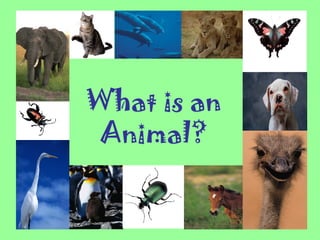
What is an animal
- 1. What is an Animal?
- 2. What is an Animal? When you think of “animals”, what pops in your mind? Lions and tigers and bears, oh my!
- 3. • But would you think of a sponge??? • The natural sponges that people use for washing are the remains of an animal • Animals come in many shapes and sizes • Some are too small to be seen without a microscope and others are bigger than a school bus • They are all part of the animal kingdom
- 4. Animal Diversity • Look at this picture. How many animals do you see?
- 5. • You may be surprised to learn that feather stars and corals are animals • Spiders, fish, and birds are also animals • And slugs, kangaroos, and monkeys are animals, too • Scientists have identified more than 1 million species of animals • Scientists believe that more than 3 million species of animals live on Earth, and most have not yet been named
- 6. Vertebrates • Vertebrate: an animal that has a backbone • Includes fish, amphibians, reptiles, birds, and mammals • Humans are one of about 5,000 species of mammals
- 7. Invertebrates • You are probably more familiar with vertebrates than invertebrates, but vertebrates are definitely the minority among living things • Less than 5% of known animal species are vertebrates • Most animal species are insects, snails, jellyfish, worms, and other invertebrates
- 8. • In fact, beetles make up more than 30% of all animal species!
- 9. Animal Characteristics All animals share characteristics that set them apart from all other living things: 1. Multicellular Makeup: – All animals are multicellular, which means made up of many cells – Eukaryotic, which means they have a nucleus – Animal cells do NOT have a cell wall – Surrounded only by cell membranes
- 10. 2. Reproduction and Development – Almost all animals reproduce sexually – These animals make sex cells: sperm and egg – When egg and sperm join, they form the first cell of a new organism, which then divides into many cells to form an embryo – Embryo: an organism at an early stage of development – Asexual reproduction- hydra reproduce by budding
- 12. 3. Many Specialized Parts – Animal’s body has distinct parts that do different things – When a fertilized egg cell divides into many cells to form an embryo, the cells become different from each other – Some cells may become skin cells, muscle cells, nerve cells, or bone cells – These different kinds of cells form tissues, which are collections of similar cells – Tissues then form organs
- 13. – Organ: group of tissues that carry out a special function of the body – Your heart, lungs, and kidneys are all organs
- 14. 4. Movement – Most animals can move from place to place – They may fly, run, swim, or jump – Nearly all animals use movement to search for food, shelter, or mates at some stage in life – Can be less active during certain stages sea anemones swim through ocean while young, then cling to rocks as adults
- 15. 5. Consuming • Animals cannot make their own food • All animals survive by eating other organisms or parts and products of other organisms • Animals are consumers an organism that eats other organisms • This trait sets animals apart from plants (there are only a few exceptions of plants that eat other organisms)
- 16. – Animals eat a great variety of foods – Examples: pandas eat bamboo
- 17. – Spiders eat other animals – Butterflies drink nectar from flowers
- 18. – All animals have to eat to survive